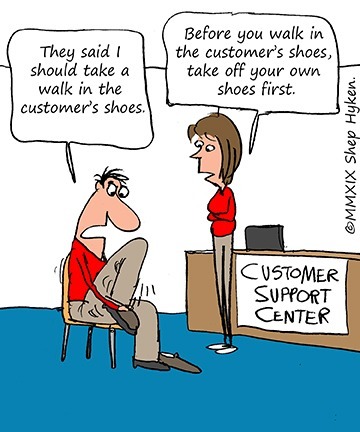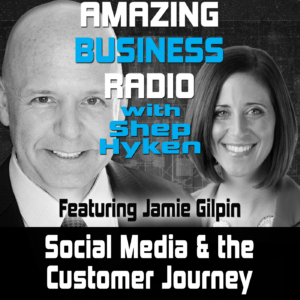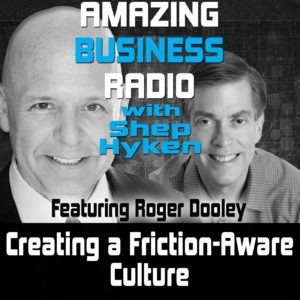Shep Hyken's Blog, page 125
June 12, 2019
Can You Take a Punch?
 In the world of boxing, the fighter must have the ability to take a punch. They have to endure or ignore the pain. They get used it. It hardly bothers them. It’s part of the job. But what does this have to do with customer service?
In the world of boxing, the fighter must have the ability to take a punch. They have to endure or ignore the pain. They get used it. It hardly bothers them. It’s part of the job. But what does this have to do with customer service?
I recently had the honor of working with Francisco Partners, a private equity firm. They invited me to address the leadership team of the companies they’ve invested in about customer service and experience. Mike Kohlsdorf, their president, met with me for breakfast to talk about the speech and he commented that when you’re on the front line, you have to be able to take a punch.
Obviously, the punch is a metaphor. In customer service, you aren’t going to be physically punched out by your unhappy customers, but you can expect to get hit with some verbal jabs.
I’m always impressed by how amazing customer service professionals can tolerate customers who are angry at them and the company. Well, there are good reasons. Here are three of them:
Customer service professionals know their job. There is a reason the people in the customer support department are called professionals. They know they are hired to be on the front line and take the metaphorical punch from the customer. They are hired for some important personality traits and skills, which could include patience, tolerance, the ability to communicate, being good-natured, the ability to stay calm under pressure, and more.
They are properly trained. Just like any good boxer that gets into the ring, customer service professionals train. More than just being able to answer questions and resolve complaints, they are also trained on how to deescalate a customer’s anger. The personalities they were hired for, along with proper training on how to handle complaints and irate customers, allow them to turn an angry customer into an advocate.
They don’t take the customer’s anger personally. It’s their job to take the verbal “punch,” yet they realize that the customer is not mad at them personally. They are mad at the company, a company-related incident, or the product and/or service the company sells. The customer service professional recognizes that while it may not be their fault, it is their opportunity to fix the problem and win the customer back.
This is what customer service professionals are good at. It’s what they are hired to do. Great companies know that training isn’t something that happens once. It’s ongoing. It’s constantly working on maintaining and improving the skills needed to make a customer happy. They make take a few hits along the way, but they “roll with the punches.” Most importantly, they don’t win the fight. They win the customer.
Shep Hyken is a customer service expert, keynote speaker, and New York Times bestselling business author. For information, contact 314-692-2200 or www.hyken.com. For information on The Customer Focus customer service training programs, go to www.thecustomerfocus.com. Follow on Twitter: @Hyken
customer service training programs, go to www.thecustomerfocus.com. Follow on Twitter: @Hyken
The post Can You Take a Punch? appeared first on Shep Hyken.
June 11, 2019
Amazing Business Radio: Randy Frisch
 From Content Marketing to Content Experience
From Content Marketing to Content ExperiencePersonalizing the Content Experience to Win Customer Loyalty
Shep Hyken interviews Randy Frisch. They discuss how content marketing has changed and what businesses need to do to create the best content experience for their customers. A good content marketing strategy is part of a good customer experience.








The Interview with Randy Frisch:
Content marketing, and consumers’ expectations of it, has changed drastically in recent years. No longer are content marketers responsible for sales only; now, they influence the entire customer experience.
In order to create a great customer and content experience, there needs to be personalization. The content that the customers come into contact with must be customized to fit their wants, needs, and interests. Companies like Amazon and Spotify are already doing this well.
Before you build and market your content, you must understand who you want to connect with. Who is your intended audience? What do they want and need? Your content must be personalized and meaningful to that audience—think of it as “contextual content.”
Successful content personalization can lead to customer loyalty. When customers feel that you truly understand them, they are more likely to make a purchase – and more likely to make repeat purchases. Customers want to do business with companies that understand them.
It’s better to have less content that is truly personalized rather than more content that is too general.
Quotes:
“Before we even start putting together the experience of content, we need to understand who we want to connect with.” – Randy Frisch
“It’s not the type or size of audience you care about, but the impact you want to make on them.” – Randy Frisch
“Use content to build customer loyalty. As soon as customers realize you understand them, then they become loyal to you.” – Randy Frisch
About:
Randy Frisch is the CMO and co-founder at Uberflip, a content experience platform. He is also a host of the Conex: The Content Experience Show podcast and the author of F#ck Content Marketing.
Shep Hyken is a customer service and experience expert, New York Times bestselling author, award-winning keynote speaker, and your host of Amazing Business Radio.
This episode of Amazing Business Radio with Shep Hyken answers the following questions … and more:
What is a CXO?
What is content marketing?
How has content marketing changed?
How can I personalize my content marketing/experience?
How can I increase customer loyalty?
The post Amazing Business Radio: Randy Frisch appeared first on Shep Hyken.
June 10, 2019
5 Top Customer Service Articles for the Week of June 10, 2019
Each week I read a number of customer service and customer experience articles from various resources. Here are my top five picks from last week. I have added my comment about each article and would like to hear what you think too.
(CallMiner) In this article, you’ll find expert tips on effective VoC survey design, as well as suggestions for effective questions that dig deeper and provide measurable, actionable insights that can inform your marketing and customer service initiatives.
My Comment: I’ve been paying attention to how good companies are getting feedback (in the form of customer surveys). The common theme is that they are short and easy on the customer. Here’s another article about surveys with some good suggestions. If you’re going to follow up the customer purchase with a survey, remember that the survey now becomes the last touch-point the customer experiences – make sure it doesn’t erode a good customer experience. So, here’s a great article on surveys that will help you gain more insights from your customers.
Improving CX: 5 Ingredients for Successful Customer Experience by LiveHelpNow!
(LiveHelpNow) Companies that score high in customer service are doing something right. We examine their customer experience strategies using five evaluation categories.
My Comment: This article takes a look at four iconic brands; Trader Joe’s, Aldi, Amazon and Chic-fil-A and offers up five ways they have created exceptional customer experiences. The categories are communication, technical competence, range of services, customer focus and accessibility. I always enjoy learning how rock-star companies amaze their customers.
How to train employees to provide customers with memorable experiences by Tara
(Freshworks) There’s an old adage in business which says that you’re not selling things, you’re selling experiences. This rings true when it comes to customer experience, which addresses the overall ease and usability of your product or service.
My Comment: The key to delivering an amazing customer experience is the employees who provide it. And, they can’t do it on their own. It takes an investment from the company they work for in the form of training. This excellent article offers up several concepts that employees need to know and understand – and most importantly, how to execute them. My personal favorite on this list is proactive customer support; getting employees to reach out to the customer before the customer reaches out to them.
The Millennial Workforce Does Not Tolerate Bad EX by Mary Drumond
(LinkedIn) In my early twenties, growing into the workforce, it always puzzled me that previous generations considered millennials (those of us born between 1982 and 2000, according to the US Census Bureau) to be “spoiled” and “entitled” because we, among other things, *wait for it* care about being happy in our jobs.
My Comment: A good customer experience starts on the inside of an organization with a good employee experience. Yet, it’s been noticed that there are generational differences in how employees expect to be treated. At the top of this topic of conversation is how to drive a better experience for the Millennial generation. There are definitely differences between generations, and with a major part of the workforce today being part of that Millennial generation, we need to know how to keep our best people. By the way, in the next five years, it is predicted that 75% of the workforce will Millennials!
What leaders can learn about customer loyalty from the Boeing debacle by Shaun Belding
(Fast Company) Boeing’s public response to the 737 Max crashes provide a case study for what businesses should and shouldn’t do, argues this customer service expert.
My Comment: The tragedy of the two Boeing 737 Max panes has put Boeing into crisis management mode. At some point, most companies will be forced into managing a crisis. While most won’t be dealing with the tragic loss of 346 lives, they will be forced to respond to issues that will either create confidence or erode trust. This is an excellent article that breaks down the way leadership has managed the Boeing crisis.
Shep Hyken is a customer service expert, professional speaker and New York Times bestselling business author. For information on The Customer Focus customer service training programs go to www.TheCustomerFocus.com. Follow on Twitter: @Hyken
customer service training programs go to www.TheCustomerFocus.com. Follow on Twitter: @Hyken
The post 5 Top Customer Service Articles for the Week of June 10, 2019 appeared first on Shep Hyken.
June 7, 2019
Guest Blog: Connect With Your Customers & Watch Your Business Grow
This week we feature an article by Molly Moore about why phone calls and online chat can make the difference between customer-centric brands and everybody else.
Despite our advances in technology today and the many ways in which we can now communicate, the phone call isn’t going anywhere. This might seem like a decidedly old-school customer service channel, but calls are as important, if not more so than ever and more consumers are calling businesses today than any other time in history.
In fact, nearly two-thirds (65%) of potential customers want to reach brands by phone. Phone calls are ripe with opportunities and the faster a caller connects with a friendly voice on the other end, the better. There’s a reason 74% of consumers are very likely to choose another business after having a poor phone experience. Consumers want to connect with your business. And we’re not only talking about phone calls; the same holds true for online chat. A whopping 73% of consumers report satisfaction with their live chat experiences—the highest level of all customer service channels—but just 14% of companies use this technology, and even fewer use it powered by real humans.
Given that 29% of calls lead to a purchase, and 77% of customers say they won’t make a purchase if a brand doesn’t offer live chat support, companies that don’t take these trends seriously risk missing out on lucrative potential revenue. But beyond the immediate opportunities, phone calls and online chat are what differentiate and insulate truly customer-centric brands in an increasingly crowded marketplace.
Consumers Demand Immediate Connection
We live in an era of ubiquitous convenience and instant gratification. An overwhelming majority (75%) of consumers now expect businesses to offer support within five minutes of an inquiry—24 hours per day, seven days per week, 52 weeks per year.
To understand these heightened expectations, look no further than the device in your hand. Smartphones and other internet-enabled mobile devices have transformed our ability to access and act on information. When someone has a question, faces a technical issue, or needs any kind of help from a business, be it a contractor, lawyer, or doctor, they’ll do a quick search to find their website. Most of these visitors have an expectation that they can tap “call now” or “chat with us” and get an immediate response.
Many companies are well aware of this, of course. However, in the rush to create effective marketing and outrank their competitors through effective strategies such as paid advertising or paid search, too many businesses fail to ultimately provide a compelling customer experience. Dollars spent on brand exposure mean nothing when callers are greeted by an answering machine, run through an automated phone tree, placed on hold for inordinate periods of time, or connected to someone who doesn’t understand or isn’t able to address their concerns. Ditto for any website visitor confronted with time-consuming forms, obtuse chatbots, or outsourced chat agents who lack linguistic and cultural fluency, or more importantly, lack a general understanding of their business.
Think your business is an exception? Think again. Although 80% of companies believe they provide excellent customer service, a mere 8% of customers agree. Clearly, organizations are dropping the ball (and dropping calls and online visitors) when it comes to delivering on customer expectations.
How to Connect the Right Way
At Ruby, we’ve spent the last 16 years helping small businesses deliver unparalleled experiences to their customers and prospects. Our employees are able to provide a personalized level of service powered by our award-winning technology platform that helps us to deliver attention to detail that consistently differentiates us. Here are a few things I’ve learned about how small businesses can grow by creating meaningful human connections:
Build trust and nail the first impression. A phone call or chat is a critical moment to either establish or destroy trust with a customer. Few channels provide the same immediacy. Use every live connection as an opportunity to set the tone and communicate your value. Establishing that trust can make a world of difference in having a potential customer schedule an appointment or take the next step with you.
Make it personal. Connection and empathy is everything. While we prioritize consistency—every call and chat inquiry gets answered with the same Ruby tone – but it’s customized to their business, making every caller and online visitor feel heard and understood.
Give your customers what they don’t even know they want. Listen carefully and you’ll seem like a mind reader. Sense hesitation in a caller’s voice? Offer to handle the hard work for them. Hear a sniffle? Send them a get-well care package. A small, personalized gesture can lay the foundation for a long-lasting relationship.
Provide a superior experience at every touchpoint. Every interaction between a customer and your company is a chance to exceed expectations. From calls to live chat, from your website to your lobby, be sure to engage and delight your customers wherever they may find you. It is critical to set this as a cultural foundation for your company at large so your customers don’t have a different experience throughout their lifecycle with your business.
Empower your team to do what they do best. You hired your customer service personnel because of their great personalities. You’ve trained them to do the right thing. Now give them the freedom to make good decisions that will result in long-lasting customer relationships. At Ruby, every team member is empowered to make someone’s day through a thoughtful gift or kind note, so when someone feels moved to send a special something to a customer, they’re free to make it happen—no questions asked.
The secret to extraordinary interactions such as phone calls and chats—or any form of customer service, for that matter—is a lesson we all learn at a young age: treat others how you would want to be treated. With the right tools, support, and mission, it can become second nature. Best of all, personal connections are a virtuous cycle. Help your customers succeed, and they’ll do the same for you.
 Molly Moore is the Chief Marketing Officer at Ruby Receptionists. Having spent nearly 20 years as a sales and marketing leader, Molly understands how to build exceptional customer experiences that win trust and build loyalty. Her focus at Ruby is on creating meaningful engagements with prospects and customers, demonstrating how Ruby’s services and technologies can help grow their businesses.
Molly Moore is the Chief Marketing Officer at Ruby Receptionists. Having spent nearly 20 years as a sales and marketing leader, Molly understands how to build exceptional customer experiences that win trust and build loyalty. Her focus at Ruby is on creating meaningful engagements with prospects and customers, demonstrating how Ruby’s services and technologies can help grow their businesses.
For more articles from Shep Hyken and his guest contributors go to customerserviceblog.com.
Read Shep’s latest Forbes article: Want To Retain Your Customers? Make It Personal
The post Guest Blog: Connect With Your Customers & Watch Your Business Grow appeared first on Shep Hyken.
June 5, 2019
Walking In Your Customer’s Shoes
 You may have heard the expression, “Take a walk in your customer’s shoes.” The idea is that you put yourself in the customer’s position and see the situation through their eyes. This is good advice for those who have customer-facing responsibilities.
You may have heard the expression, “Take a walk in your customer’s shoes.” The idea is that you put yourself in the customer’s position and see the situation through their eyes. This is good advice for those who have customer-facing responsibilities.
You may have heard other versions of this expression. One of the more humorous versions is, “Walk a mile in your customer’s shoes, and once you’re a mile away, you can say anything you want about the customer and they can’t hear you.”
I said it was humorous. I didn’t say it was right.
Recently, I was speaking at a convention in Philadelphia, where I heard another version of the phrase. This one’s a good one. “Before you walk in the customer’s shoes, take off your own shoes.”
What this means is that even though we try to see the experience through the customer’s eyes, we sometimes don’t – or can’t – because we know too much from being on the inside of the company. It’s hard to separate ourselves from what we think the customer perceives versus what the customer actually experiences.
Years ago I came up with a short poem: Think like the buyer, not like the supplier. That’s it. It’s just one line. I would have used the word customer instead of buyer, but I couldn’t come up with a good rhyme. The point of the poem is similar to the idea of walking in the customer’s shoes. We need to get inside the heads and hearts of our customers and step away from our company roles before we can truly understand what the customer is thinking about us.
However you say it, there’s only one way to do it. You can’t talk about it in a conference room with your colleagues. You must become the customer. Depending on your type of business, there are different ways to do so. Call your company from the outside and experience what it’s really like to go through the phone tree or be put on hold. Make a call to the sales department or go visit a store as a customer. Experience all you can from the customer’s perspective.
We want our customers to have a great experience. The only person who can really judge your success is the customer. The customer is the judge and jury on that one.
Do your perceptions of the customer’s experience align with the customer’s reality? Take a walk in your customer’s shoes – after taking yours off – and find out.
Shep Hyken is a customer service expert, keynote speaker, and New York Times bestselling business author. For information, contact 314-692-2200 or www.hyken.com. For information on The Customer Focus customer service training programs, go to www.thecustomerfocus.com. Follow on Twitter: @Hyken
customer service training programs, go to www.thecustomerfocus.com. Follow on Twitter: @Hyken
The post Walking In Your Customer’s Shoes appeared first on Shep Hyken.
June 4, 2019
Amazing Business Radio: Jamie Gilpin

Social Media and the Customer Journey
Human Connections Through a Digital Platform
Shep Hyken interviews Jamie Gilpin. They discuss how the role of marketers has expanded to include the customer experience, and how social media can positively affect the customer journey.








The Interview with Jamie Gilpin:
The advent of social media has opened new channels for marketers. Marketing is no longer concerned with sales alone; now, marketers must take the whole customer experience into consideration. Social media can provide invaluable insights to marketers for every stage of the customer journey.
A company’s brand is not determined by first impressions and advertising alone. It is now affected at every interaction and experience a customer has with a company and is comprised of that customer’s feelings toward the company. Marketers can use social media as a tool to manage customers’ impressions and define the company’s brand.
There are many areas in which marketers no longer have control of a company’s brand. Social media puts control into the hands of the customers, which can create problems when customers use social media as a megaphone to advertise their issues with a company. However, handled well, this also creates an opportunity for marketers to take back control, using those channels to steer the impression other consumers will form of the brand.
There is a difference between a satisfied customer and a loyal customer. Customers become loyal when they’re not only satisfied, but when they feel a true connection to the company. Loyal customers then become advocates for a brand by recommending it to their friends and family.
Customers crave authentic, human connection more than anything else, and this is ultimately what drives sales and loyalty. Social media is arguably one of the biggest connection points in the customer experience. Companies must realize this and take advantage of this opportunity to create connection.
It’s important to identify and uphold a purpose for your company. If your purpose aligns with your customers’ values, this will drive connection and loyalty. However, the purpose must be authentic; otherwise, it will drive customers away. Listen on social media to what your customers are saying to learn what their values, wants, and needs are.
It’s crucial to truly know and understand your customers. Social media is an under-utilized treasure trove of information; use this tool to get to know your customers and connect with them on an authentic, human level.
Quotes:
“Our brand isn’t determined just by the first interaction with customers. It’s determined by the entire life cycle they have with us.” – Jamie Gilpin
“Consumers expect brands to be more transparent, more human, and more authentic, especially on social media, than our political leaders, themselves, and even their friends and family.” – Jamie Gilpin
“The largest, most unfiltered source of business intelligence for customer knowledge and connection is social media.” – Jamie Gilpin
About:
Jamie Gilpin is the Chief Marketing Officer at Sprout Social, a leading provider of social media analytics, engagement, and advocacy solutions for business. She received her MBA from Northwestern University.
Shep Hyken is a customer service and experience expert, New York Times bestselling author, award-winning keynote speaker, and your host of Amazing Business Radio.
This episode of Amazing Business Radio with Shep Hyken answers the following questions … and more:
How has the role of marketers changed because of social media?
What do customers want from a brand/company?
How can you use social media as a business tool?
What makes customers loyal?
How does marketing affect the customer experience?
The post Amazing Business Radio: Jamie Gilpin appeared first on Shep Hyken.
June 3, 2019
5 Top Customer Service Articles for the Week of June 3, 2019
Each week I read a number of customer service and customer experience articles from various resources. Here are my top five picks from last week. I have added my comment about each article and would like to hear what you think too.
10 Ways to Improve Your Customer Experience (CX) by Diana Kaemingk
(Qualtrics) If you’re ready to improve your customer experience, check out these 10 tips.
My Comment: If you’ve been following this weekly roundup, you know I’m a big fan of lists. Here’s a good “Top Ten” type of list to help you improve your customer experience. Some of these are common sense – but that doesn’t mean their all that common.
10 Steps To Achieve Greater Customer Success by Emily Marchant
(ProProfs) Read this article to learn the 10 steps that are a must in your customer success plan for ensuring greater customer success stories in your business.
My Comment: And, here’s another list – and another ten ideas – that will help you create a level of customer service and experience that will “ensure greater customer success stories” in your business.
5 Customer Experience Basics to Avoid a Customer Service Nightmare by Erin Ollila
(SmarterCX) In the vocal world of social media we live in, poor customer experiences can quickly turn into public customer service nightmares. Here are 5 customer experience basics to master in your organization.
My Comment: Another list! This time five customer service basics you must do to avoid, as the title implies, a customer service nightmare. One of my favorites on the list is number three, which is to “Honor Your Word.” I don’t think many companies lie to customers, but when something promised doesn’t happen for any reason, the customer may begin to lose trust and confidence in the company.
7 Must-Know Types of Customer Survey Questions with Tips and Examples by Delighted
(Delighted) In this post, we’ll break down the 7 types of survey questions and answer scales, and the pros and cons of each.
My Comment: This list focuses on different types of survey questions. Customers are getting survey fatigue. Too many questions – and too many surveys! So, the right types of questions can go a long way in getting your customers to share their feedback.
Why The Most Trusted Brands Will Also Be The Most Successful by Aarron Spinley
(Which-50) Who do you trust? More importantly, do your customers trust you? This year’s global Edelman Trust Index revealed a critical development in consumer sentiment around the world.
My Comment: Breaking away from this week’s theme of “lists,” here is an article about one of the most important concepts in business… trust! The old saying is that customers want to buy from people they know, like and trust. Trust inspires confidence with your customers. Confidence can lead to more business.
Shep Hyken is a customer service expert, professional speaker and New York Times bestselling business author. For information on The Customer Focus customer service training programs go to www.TheCustomerFocus.com. Follow on Twitter: @Hyken
customer service training programs go to www.TheCustomerFocus.com. Follow on Twitter: @Hyken
The post 5 Top Customer Service Articles for the Week of June 3, 2019 appeared first on Shep Hyken.
May 31, 2019
Guest Blog: Ways to Improve Your Customer Experience Online
This week we feature an article by Abdul Babar who explains why your customer experience strategy must be a priority for any customer-facing organization.
If we were to inquire as to the last time you had an exceptional experience as a customer it wouldn’t likely take you long to describe the lasting impression made upon you by a brand and how pleased you were with the outcome. Same goes for a poor experience and how badly it turned you off from that company, brand or product.
A positive customer experience isn’t just about “feel good” experiences, it is about branding, market positioning, perception, and at the end of the day, your bottom line.
In today’s highly competitive landscape, customer experience should constitute a key area of operational priority for any customer-facing organization.
A well-planned customer experience strategy can have an impressive impact on your organization, increasing customer satisfaction, reducing churn, and ultimately boosting sales, growth and profitability.
What is the customer experience?
Most of us are well-acquainted with the term “customer service”. But what does “customer experience” mean and how does it differ?
The customer experience can include a lot of elements, including any interaction that the customer has with your brand during their customer journey, from first learning you exist, all the way through onboarding and becoming a paying customer.
Your customer’s perception of your brand is shaped by their customer experience. Every stage of a customer’s interaction with your brand should be considered, from the discovery, purchase and service to follow up and advocacy. The quality of this experience will affect the conversations your customer has both on and offline. These conversations directly impact on the way that your brand is perceived.
How customer experience is different from user experience and customer service
The customer experience encompasses both the user experience and customer service. The term ‘customer service’ refers to any direct correspondence that your customers have with your organization.
For example, the way you respond to a customer who is experiencing an issue with your product or service would be summed up as their customer experience. The ‘user experience’ refers to any interactions that your website or app users have with that particular piece of software.
Ways to improve your customer experience online
Understand your audience profile
If you want to create a great customer experience, you first need to know who your customers are. You need to profile the customers that will use your product or service and understand their motivations, concerns and needs. There are a few ways that you can get a clear picture of your customer. You could speak to members of your customer service team to build a picture of your customers and their needs and concerns. You can also use analytics data to better understand your customer demographics, interests and behaviors.
Once you have this information, you can build your customer persona(s). You should build your customer personas into realistic characters.
Think about the experience you want to deliver and work backward
Make a list of all the touchpoints that your customers may have with your brand. Each touchpoint is your opportunity to make an impression, so focus on communicating your USPs at each touchpoint. Then focus on solving problems that your customers may encounter at these various touch points. Even solving very small problems can have a big impact.
Ensure your team is invested in improving the customer experience
It is crucial that your employees are dedicated to creating a great customer experience. Make sure you hire people who are passionate about ensuring that every customer receives the best possible experience online.
A key component to understanding how your customers and prospective customers react to and perceive their experience with your brand is through reputation and brand monitoring. Services such as ReputationDesk can help brands track, monitor and react to feedback across the web and social media, allowing them to use real data to shape their customer experience strategy.
Use customer feedback constructively
Listen to the feedback that your customers give you online and use it to influence your next move. Don’t be offended by negative feedback, use it to improve your customer experience.
Give your brand a strong personality
Make sure that your brand has a memorable personality. A strong brand personality can dramatically improve your customer experience online and help you to build loyalty with your customers. Ask yourself, if your brand was a real person, what sort of person would they be? Build them a persona in the same way that you built your customer personas.
Closing Thoughts
There are many other ways to improve your customer experience online but remember to start with the customer. There is no limit to the benefits that a strong customer experience strategy can give to your organization.
Abdul Babar is the Chief Marketing Officer of Reputation Desk, an all in one Reputation Management Platform founded by business owners to help other businesses look their best online and in their local areas.
For more articles from Shep Hyken and his guest contributors go to customerserviceblog.com.
Read Shep’s latest Forbes article: Ten Customer Experience (CX) Strategies To Amaze Your Customers
The post Guest Blog: Ways to Improve Your Customer Experience Online appeared first on Shep Hyken.
May 29, 2019
Starting Over – Part Two
 The sun always rises tomorrow!
The sun always rises tomorrow!
The other day my friend and one of our avid Shepard Letter readers, Doug Schukar, shared this quote he heard over and over from his father growing up. I knew Doug’s father, the late and great Buzzie Schukar, a larger-than-life man who loved life and always had good advice. “The sun always rises tomorrow” is exactly the kind of advice Buzzie would espouse to his son – and his friends. My take on this is that no matter how tough the day is, tomorrow is another day… and of course, the sun will rise.
I’ve written and spoken about how bad days only last 24 hours. That’s another way of saying it; that tomorrow is another day. And, of course, the sun will rise. These are words I live my life by, and I encourage you to do the same. The concept of starting over is also an optimistic viewpoint that tomorrow will be a better day, especially if today was a bad day. It applies to us in our personal lives, but also in the business world, especially in customer service.
Previously, I’ve shared the concept of starting over in one of my books. When I first wrote about this idea, it had to do with the idea that no matter how good we are today, tomorrow is a new day and we must start over. We’re only as good as our last customer interaction, so we need to see every customer interaction as an opportunity.
Sometimes customers – both internal and external customers – aren’t easy to deal with. They may have complaints, problems, or even be upset or angry. We do our very best as professionals, regardless of what our roles are in the organizations where we work. We work to fix problems, resolve issues, and make our customers happy. Even when we are successful, and we usually are, the stress of dealing with any negative situation can impact the conversation we have with the next customer.
That is where the concept of starting over applies. At the end of every interaction, good or bad, it’s time to start over. If the conversation was a tough one, put it behind you and move on. If it’s a good interaction, don’t rest on success. Strive to be even better next time – every time. Start over with a clean slate. That may mean you’re starting over immediately with the next customer, or you’re going home and will start afresh tomorrow. Regardless, it’s a new beginning – and the sun will once again rise.
Shep Hyken is a customer service expert, keynote speaker, and New York Times bestselling business author. For information, contact 314-692-2200 or www.hyken.com. For information on The Customer Focus customer service training programs, go to www.thecustomerfocus.com. Follow on Twitter: @Hyken
customer service training programs, go to www.thecustomerfocus.com. Follow on Twitter: @Hyken
The post Starting Over – Part Two appeared first on Shep Hyken.
May 28, 2019
Amazing Business Radio: Roger Dooley
 Creating a Friction-Aware Culture
Creating a Friction-Aware CultureChanging Friction to Deliver a Better Customer Experience
Shep Hyken interviews Roger Dooley. They discuss his new book, Friction: The Untapped Force That Can Be Your Most Powerful Advantage, and how it applies to the customer experience.








The Interview with Roger Dooley:
Friction is “any unnecessary expenditure of effort to accomplish a task.” This effort can include both time and money and affects both customers and employees. Not eliminating friction can cost you the loyalty of both your customers and your employees alike.
Businesses need to develop a “friction-aware culture.” Once you’re aware, not only will you see friction everywhere, but you can start to fix it. A smoother CX results in happier customers, higher sales, and a more productive and engaged team.
Trust and friction work in direct opposition to one another. Sometimes we will put up with extra friction to trust in security (i.e., a safety deposit box). But there is often a mismatch between trust and friction, such as complicated online security measures that only frustrate the customer. For your customers to trust you, you must demonstrate that you trust them.
Sometimes adding friction can have beneficial results. For instance, moving a candy dish just a few feet further can help someone change their diet. Alternatively, adding a high-friction option results in consumers choosing the low-friction option.
Friction and human behavior are linked. Changing friction (usually reducing it) allows you to steer human behavior. It is rare to see positive results from adding friction; if you do add friction, it can’t be too much or you will see adverse effects. There must be a balance.
Opportunities can be greater for small businesses because they are less likely to have internal friction and can, therefore, be more creative.
It is crucial for executives and organization leaders to observe their customers, rather than making disconnected assumptions about what’s working and what isn’t. Observation allows you to see where friction exists for your customers so that you can make changes where necessary.
Quotes:
“Wasting your customers’ time and effort will cost you their loyalty.” – Roger Dooley
“Friction changes human behavior. If you want to steer that behavior, you can change friction.” – Roger Dooley
“Friction changes behavior whether it is in a customer experience, an employee experience, or your daily life. By changing friction—usually by eliminating it—you can get great positive outcomes.” – Roger Dooley
About:
Roger Dooley is an author and international keynote speaker. He founded Dooley Direct, a consultancy, and co-founded College Confidential, the leading college-bound website.
Shep Hyken is a customer service and experience expert, New York Times bestselling author, award-winning keynote speaker, and your host of Amazing Business Radio.
This episode of Amazing Business Radio with Shep Hyken answers the following questions … and more:
How can technology help my customer service?
How do I hire the right people?
How do I train my employees?
How do I empower my employees?
How can I make my customers happy?
The post Amazing Business Radio: Roger Dooley appeared first on Shep Hyken.



